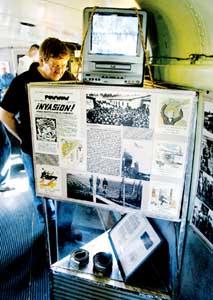 |
| Herald
photo by John Stennes |
| Vietnam
veteran Mike Hanson, from Cooperstown, N.D. tours the
"Behind Barbed Wire" bus Monday in Grand Forks. The traveling
exhibit about midwest prisoners of war in Nazi Germany
will make stops today in Warren, Hallock and Roseau, Minn.
|
POW exhibit stops in area
 Traveling exhibit details lives of Midwest
POWs in Nazi Germany.
Traveling exhibit details lives of Midwest
POWs in Nazi Germany.
 By Rona K. Johnson
By Rona K. Johnson
 Herald Staff Writer
Herald Staff Writer
An exhibit called "Behind Barbed
Wire: POWs in Nazi Germany" gives visitors a glimpse into the
lives of Midwesterners held in German prison camps.
The exhibit, based in a converted
school bus, was parked in the Grand Forks Public Library parking
lot Monday evening and will stop at three northwestern Minnesota
libraries today. The exhibit drew a record 357 people in Thief
River Falls on Monday morning, according to Michael Luick-Thrames,
guest historian. He expected about the same size crowd would
turn out in Grand Forks based on early traffic.
Luick-Thrames is executive director
of Traces, a nonprofit organization created to collect and preserve
experiences of Midwesterners, Germans and Austrians during WWII.
The exhibit included photos of life
in the prison camps, a map of the prison camps in Nazi Germany,
an example of POW camp currency and POW art. The narrative portion
of the exhibit explained what life in prison camps was like,
from the Germans' interrogation techniques to escape attempts.
Visitors to the display were asked
before entering the bus to read a poster that explained how
most POWs either were captured in North Africa in 1943, were
pilots shot out of the sky during the air war over Europe or
were soldiers captured at the Battle of the Bulge.
"All of the men who survived them,
however, left a provocative legacy for those alive today - one
involving the very nature of war itself: How does armed conflict
between groups of people play out, face-to-face, when the guns
are lowered; how 'should' humans treat each other and, ultimately,
live together?"
Family memories
One of Monday's visitors was Esther
Blecha, 77. The former Central High School German teacher visited
the display because she grew up during WWII and because she's
a history buff.
Blecha's husband, Clarence, served
in the South Pacific during WWII and her cousin drowned during
a D-Day training exercise.
"He never got a Purple Heart because
it was top secret," Blecha said. But, she said, her cousin's
family in Bismarck is trying to get his medal, which is awarded
to members of the armed forces who are wounded in battle or
to the next of kin of soldiers who were killed in action or
died of wounds received in action.
Today the exhibit travels to Minnesota
and will be at the Warren Public Library from 8 a.m. to noon;
the Hallock Public Library from 1 to 4 p.m.; and the Roseau
Public Library from 5:30 to 9:30 p.m. |

